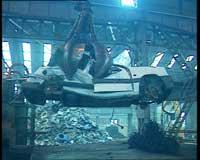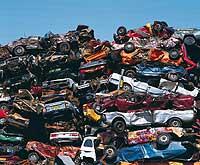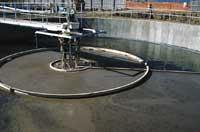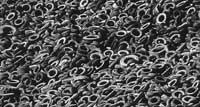Old car depots extinction
2004/04/21 Pikabea Amundarain, Nerea - Elhuyar Zientziaren Komunikazioa
The recent legislation passed by the European Union on out-of-use vehicles will soon prohibit the withdrawal of vehicles. Cars cannot be stacked anywhere and must be removed before destruction.

The European Union is committed for 2006 to recycle 85% of the components of vehicles and convert them into energy by 5%. In most European scrambles, cars are outdoors. The new legislation aims to prevent contamination of soil and the environment, but also the saving of raw materials and energy.
Millions of cars per year
Sestao Car Recycling began implementing the new regulations a year ago and last year 2,000 vehicles were treated. This year, for its part, it is expected to reach 6,000 euros and from 2005 to 9,000 each year. However, this figure does not represent a fifth of the cars that are discarded annually in the Autonomous Community of the Basque Country. In the Autonomous Community of the Basque Country each year, some 50,000 vehicles are discarded, which in the whole of Europe amount to about 150 million.
Car Rcycling also collects motorists, town halls and citizens the cars they treat in Sestao. The first phase of the process consists in the fractionation of cars, the separation of polluting components and the classification of parts in three working areas depending on the condition of vehicles.
At the moment, plastic scraps and wheels are taken to landfill, but the company's goal is to make a comprehensive recycling in the future. The process starts after weighing the vehicle. The first thing to do is to decontaminate the car: remove wheels, plastics and battery; then absorb oil, antifreeze, brake fluid and fuel; and the same with air conditioner and air-bags gases. All this is collected and made available to authorized companies for waste treatment.
Then we proceed to the separation and classification of each piece for further reuse. All engine parts, gearboxes, etc. are reused, remanufactured. for new cars. Once all the pieces are removed, what remains is transferred to the scrap.

Santiago Perea, managing director of Car Recycling, explains that once all the parts are removed, the part will take a path or another depending on the market to be used. "The first includes the scrapping workshops in the area, which include mechanical parts or car peripherals for old cars. Another market is that of helmets, large parts that are aimed at manufacturers of them for remanufacture and sale as spare parts. And the third market is third world countries that consume spare parts or used cars directly, parts of almost all models, motors, alternators, etc. ".
Shortly Car Recycling will open centers such as the Sestao factory in Gipuzkoa and Araba, as well as in other parts of the State and Portugal. In total, around 40 workshops will be held.
Intended for recycling
According to EU regulations, by 2015 it will be necessary to recycle 95% of vehicle components, so some manufacturers have already started to manufacture parts differently in some places in Europe to facilitate their subsequent recycling. If 22 plastics are currently used in the automotive sector, then only 2 or 3 types of plastics would be produced and used. In addition, the designs are being modified to facilitate the dismantling of the cars.

Gai honi buruzko eduki gehiago
Elhuyarrek garatutako teknologia





